| Leaves | |
|---|---|
 | |
| Native names | German: Laub, Blatt, Schippen, Gras or Grün |
| Deck | German-suited playing cards |
| Invented | 15th century |
Leaves (![]() ) (German: Laub) is one of the four playing card suits in a deck of German-suited playing cards. This suit was invented in 15th century Germany and is a survivor from a large pool of experimental suit signs created to replace the Latin suits. Around 1480, French card makers adapted this sign into Spades in the French pack (known as pikes in France).[1]
) (German: Laub) is one of the four playing card suits in a deck of German-suited playing cards. This suit was invented in 15th century Germany and is a survivor from a large pool of experimental suit signs created to replace the Latin suits. Around 1480, French card makers adapted this sign into Spades in the French pack (known as pikes in France).[1]
As its name suggests, the leaf is represented by a stylized green leaf. The left half is lighter than the right half; it can sometimes be yellow. Veins are visible and there is usually a petiole. There may also be smaller leaves.
Names
They are usually known in German as Laub ("foliage"), but also as Gras ("grass"), Blatt ("leaf") or 'Grün ("green"). Cards are referred to as in a French pack e.g. the "King of Leaves", but in German as Laub-König or Grün-König i.e. "Leaf King". It is the second-highest suit in the games of Skat, Schafkopf and Doppelkopf, and the second lowest in Préférence.
Gallery
Today the suit of leaves is still produced as part of the following patterns: Bavarian (Types M and S), Bohemian, East German, Franconian, Saxonian and William Tell. The gallery below shows a suit of Leaves from a German-suited playing cards of 32 cards. The pack is of the Saxonian pattern:
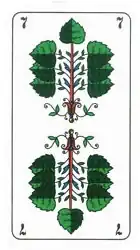 7
7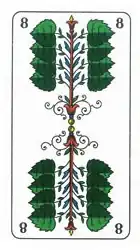 8
8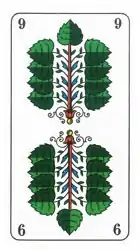 9
9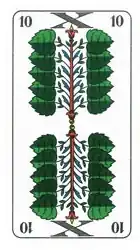 10
10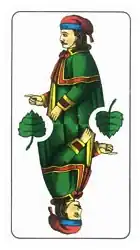
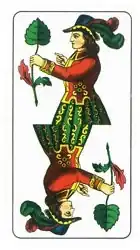
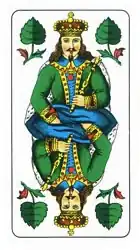
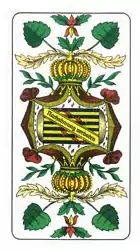
Swiss cards
In Swiss-suited playing cards, the equivalent suit is Shields, typically with the following suit symbol: ![]() .
.
References
- ↑ Dummett, Michael (1980). The Game of Tarot. London: Duckworth. pp. 10–32.